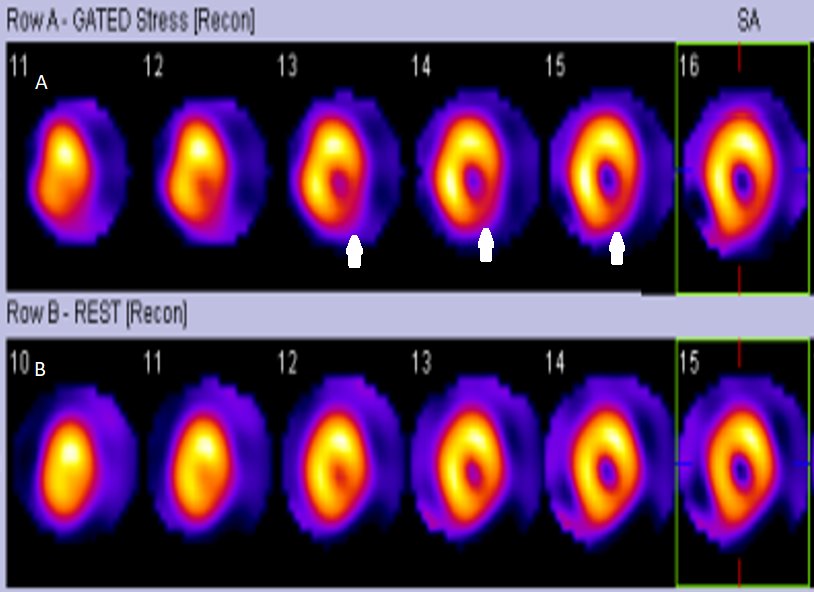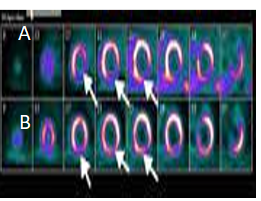[1]
Shaw LJ, Marwick TH, Zoghbi WA, Hundley WG, Kramer CM, Achenbach S, Dilsizian V, Kern MJ, Chandrashekhar Y, Narula J. Why all the focus on cardiac imaging? JACC. Cardiovascular imaging. 2010 Jul:3(7):789-94. doi: 10.1016/j.jcmg.2010.05.004. Epub
[PubMed PMID: 20633864]
[2]
Bhattacharyya S, Lloyd G. Improving Appropriateness and Quality in Cardiovascular Imaging: A Review of the Evidence. Circulation. Cardiovascular imaging. 2015 Dec:8(12):. pii: e003988. doi: 10.1161/CIRCIMAGING.115.003988. Epub
[PubMed PMID: 26628582]
Level 2 (mid-level) evidence
[3]
Mankoff DA. A definition of molecular imaging. Journal of nuclear medicine : official publication, Society of Nuclear Medicine. 2007 Jun:48(6):18N, 21N
[PubMed PMID: 17536102]
[4]
Lindner JR, Sinusas A. Molecular imaging in cardiovascular disease: Which methods, which diseases? Journal of nuclear cardiology : official publication of the American Society of Nuclear Cardiology. 2013 Dec:20(6):990-1001. doi: 10.1007/s12350-013-9785-0. Epub
[PubMed PMID: 24092271]
[5]
Ohira H, Mc Ardle B, Cocker MS, deKemp RA, Dasilva JN, Beanlands RS. Current and future clinical applications of cardiac positron emission tomography. Circulation journal : official journal of the Japanese Circulation Society. 2013:77(4):836-48
[PubMed PMID: 23486164]
[6]
Krumm P, Mangold S, Gatidis S, Nikolaou K, Nensa F, Bamberg F, la Fougère C. Clinical use of cardiac PET/MRI: current state-of-the-art and potential future applications. Japanese journal of radiology. 2018 May:36(5):313-323. doi: 10.1007/s11604-018-0727-2. Epub 2018 Mar 10
[PubMed PMID: 29524169]
[7]
Massoud TF, Gambhir SS. Molecular imaging in living subjects: seeing fundamental biological processes in a new light. Genes & development. 2003 Mar 1:17(5):545-80
[PubMed PMID: 12629038]
[8]
Dorbala S, Di Carli MF, Beanlands RS, Merhige ME, Williams BA, Veledar E, Chow BJ, Min JK, Pencina MJ, Berman DS, Shaw LJ. Prognostic value of stress myocardial perfusion positron emission tomography: results from a multicenter observational registry. Journal of the American College of Cardiology. 2013 Jan 15:61(2):176-84. doi: 10.1016/j.jacc.2012.09.043. Epub 2012 Dec 5
[PubMed PMID: 23219297]
[9]
Kobylecka M, Mączewska J, Fronczewska-Wieniawska K, Mazurek T, Płazińska MT, Królicki L. Myocardial viability assessment in 18FDG PET/CT study (18FDG PET myocardial viability assessment). Nuclear medicine review. Central & Eastern Europe. 2012 Apr 24:15(1):52-60. doi: 10.5603/nmr-18731. Epub 2012 Apr 24
[PubMed PMID: 23047574]
[10]
Li Z, Gupte AA, Zhang A, Hamilton DJ. Pet Imaging and its Application in Cardiovascular Diseases. Methodist DeBakey cardiovascular journal. 2017 Jan-Mar:13(1):29-33. doi: 10.14797/mdcj-13-1-29. Epub
[PubMed PMID: 28413580]
[11]
Blankstein R, Osborne M, Naya M, Waller A, Kim CK, Murthy VL, Kazemian P, Kwong RY, Tokuda M, Skali H, Padera R, Hainer J, Stevenson WG, Dorbala S, Di Carli MF. Cardiac positron emission tomography enhances prognostic assessments of patients with suspected cardiac sarcoidosis. Journal of the American College of Cardiology. 2014 Feb 4:63(4):329-36. doi: 10.1016/j.jacc.2013.09.022. Epub 2013 Oct 16
[PubMed PMID: 24140661]
[12]
Tamaki N, Kawamoto M, Tadamura E, Magata Y, Yonekura Y, Nohara R, Sasayama S, Nishimura K, Ban T, Konishi J. Prediction of reversible ischemia after revascularization. Perfusion and metabolic studies with positron emission tomography. Circulation. 1995 Mar 15:91(6):1697-705
[PubMed PMID: 7882476]
[13]
Saby L, Laas O, Habib G, Cammilleri S, Mancini J, Tessonnier L, Casalta JP, Gouriet F, Riberi A, Avierinos JF, Collart F, Mundler O, Raoult D, Thuny F. Positron emission tomography/computed tomography for diagnosis of prosthetic valve endocarditis: increased valvular 18F-fluorodeoxyglucose uptake as a novel major criterion. Journal of the American College of Cardiology. 2013 Jun 11:61(23):2374-82. doi: 10.1016/j.jacc.2013.01.092. Epub 2013 Apr 10
[PubMed PMID: 23583251]
[14]
Jaswal JS, Keung W, Wang W, Ussher JR, Lopaschuk GD. Targeting fatty acid and carbohydrate oxidation--a novel therapeutic intervention in the ischemic and failing heart. Biochimica et biophysica acta. 2011 Jul:1813(7):1333-50. doi: 10.1016/j.bbamcr.2011.01.015. Epub 2011 Jan 20
[PubMed PMID: 21256164]
[15]
Amaral N, Okonko DO. Metabolic abnormalities of the heart in type II diabetes. Diabetes & vascular disease research. 2015 Jul:12(4):239-48. doi: 10.1177/1479164115580936. Epub 2015 May 4
[PubMed PMID: 25941161]
[16]
Barger PM, Kelly DP. Fatty acid utilization in the hypertrophied and failing heart: molecular regulatory mechanisms. The American journal of the medical sciences. 1999 Jul:318(1):36-42
[PubMed PMID: 10408759]
[17]
Hamirani YS, Kundu BK, Zhong M, McBride A, Li Y, Davogustto GE, Taegtmeyer H, Bourque JM. Noninvasive Detection of Early Metabolic Left Ventricular Remodeling in Systemic Hypertension. Cardiology. 2016:133(3):157-62. doi: 10.1159/000441276. Epub 2015 Nov 24
[PubMed PMID: 26594908]
[18]
Wolk MJ, Bailey SR, Doherty JU, Douglas PS, Hendel RC, Kramer CM, Min JK, Patel MR, Rosenbaum L, Shaw LJ, Stainback RF, Allen JM, American College of Cardiology Foundation Appropriate Use Criteria Task Force. ACCF/AHA/ASE/ASNC/HFSA/HRS/SCAI/SCCT/SCMR/STS 2013 multimodality appropriate use criteria for the detection and risk assessment of stable ischemic heart disease: a report of the American College of Cardiology Foundation Appropriate Use Criteria Task Force, American Heart Association, American Society of Echocardiography, American Society of Nuclear Cardiology, Heart Failure Society of America, Heart Rhythm Society, Society for Cardiovascular Angiography and Interventions, Society of Cardiovascular Computed Tomography, Society for Cardiovascular Magnetic Resonance, and Society of Thoracic Surgeons. Journal of the American College of Cardiology. 2014 Feb 4:63(4):380-406. doi: 10.1016/j.jacc.2013.11.009. Epub 2013 Dec 16
[PubMed PMID: 24355759]
[19]
Boellaard R, O'Doherty MJ, Weber WA, Mottaghy FM, Lonsdale MN, Stroobants SG, Oyen WJ, Kotzerke J, Hoekstra OS, Pruim J, Marsden PK, Tatsch K, Hoekstra CJ, Visser EP, Arends B, Verzijlbergen FJ, Zijlstra JM, Comans EF, Lammertsma AA, Paans AM, Willemsen AT, Beyer T, Bockisch A, Schaefer-Prokop C, Delbeke D, Baum RP, Chiti A, Krause BJ. FDG PET and PET/CT: EANM procedure guidelines for tumour PET imaging: version 1.0. European journal of nuclear medicine and molecular imaging. 2010 Jan:37(1):181-200. doi: 10.1007/s00259-009-1297-4. Epub
[PubMed PMID: 19915839]
[21]
Demeure F, Hanin FX, Bol A, Vincent MF, Pouleur AC, Gerber B, Pasquet A, Jamar F, Vanoverschelde JL, Vancraeynest D. A randomized trial on the optimization of 18F-FDG myocardial uptake suppression: implications for vulnerable coronary plaque imaging. Journal of nuclear medicine : official publication, Society of Nuclear Medicine. 2014 Oct:55(10):1629-35. doi: 10.2967/jnumed.114.138594. Epub 2014 Jul 31
[PubMed PMID: 25082852]
Level 1 (high-level) evidence
[22]
Nakazato R, Berman DS, Alexanderson E, Slomka P. Myocardial perfusion imaging with PET. Imaging in medicine. 2013 Feb 1:5(1):35-46
[PubMed PMID: 23671459]
[23]
Koepfli P, Hany TF, Wyss CA, Namdar M, Burger C, Konstantinidis AV, Berthold T, Von Schulthess GK, Kaufmann PA. CT attenuation correction for myocardial perfusion quantification using a PET/CT hybrid scanner. Journal of nuclear medicine : official publication, Society of Nuclear Medicine. 2004 Apr:45(4):537-42
[PubMed PMID: 15073247]
[24]
Dhar R, Ananthasubramaniam K. Rubidium-82 cardiac positron emission tomography imaging: an overview for the general cardiologist. Cardiology in review. 2011 Sep-Oct:19(5):255-63. doi: 10.1097/CRD.0b013e318224253e. Epub
[PubMed PMID: 21808169]
Level 3 (low-level) evidence
[25]
Fathala A, Aboulkheir M, Shoukri MM, Alsergani H. Diagnostic accuracy of (13)N-ammonia myocardial perfusion imaging with PET-CT in the detection of coronary artery disease. Cardiovascular diagnosis and therapy. 2019 Feb:9(1):35-42. doi: 10.21037/cdt.2018.10.12. Epub
[PubMed PMID: 30881875]
[26]
Knuuti J, Kajander S, Mäki M, Ukkonen H. Quantification of myocardial blood flow will reform the detection of CAD. Journal of nuclear cardiology : official publication of the American Society of Nuclear Cardiology. 2009 Jul-Aug:16(4):497-506. doi: 10.1007/s12350-009-9101-1. Epub 2009 Jun 3
[PubMed PMID: 19495903]
[27]
Moody JB, Poitrasson-Rivière A, Hagio T, Buckley C, Weinberg RL, Corbett JR, Murthy VL, Ficaro EP. Added value of myocardial blood flow using (18)F-flurpiridaz PET to diagnose coronary artery disease: The flurpiridaz 301 trial. Journal of nuclear cardiology : official publication of the American Society of Nuclear Cardiology. 2021 Oct:28(5):2313-2329. doi: 10.1007/s12350-020-02034-2. Epub 2020 Jan 30
[PubMed PMID: 32002847]
[28]
Tillisch J, Brunken R, Marshall R, Schwaiger M, Mandelkern M, Phelps M, Schelbert H. Reversibility of cardiac wall-motion abnormalities predicted by positron tomography. The New England journal of medicine. 1986 Apr 3:314(14):884-8
[PubMed PMID: 3485252]
[29]
Nakazato R, Berman DS, Dey D, Le Meunier L, Hayes SW, Fermin JS, Cheng VY, Thomson LE, Friedman JD, Germano G, Slomka PJ. Automated quantitative Rb-82 3D PET/CT myocardial perfusion imaging: normal limits and correlation with invasive coronary angiography. Journal of nuclear cardiology : official publication of the American Society of Nuclear Cardiology. 2012 Apr:19(2):265-76. doi: 10.1007/s12350-011-9496-3. Epub 2011 Dec 28
[PubMed PMID: 22203445]
[30]
Lubberink M, Harms HJ, Halbmeijer R, de Haan S, Knaapen P, Lammertsma AA. Low-dose quantitative myocardial blood flow imaging using 15O-water and PET without attenuation correction. Journal of nuclear medicine : official publication, Society of Nuclear Medicine. 2010 Apr:51(4):575-80. doi: 10.2967/jnumed.109.070748. Epub 2010 Mar 17
[PubMed PMID: 20237035]
[31]
Rosas EA, Slomka PJ, García-Rojas L, Calleja R, Jácome R, Jiménez-Santos M, Romero E, Meave A, Berman DS. Functional impact of coronary stenosis observed on coronary computed tomography angiography: Comparison with ¹³N-ammonia PET. Archives of medical research. 2010 Nov:41(8):642-8. doi: 10.1016/j.arcmed.2010.11.002. Epub
[PubMed PMID: 21199734]
[32]
Kaster T, Mylonas I, Renaud JM, Wells GA, Beanlands RS, deKemp RA. Accuracy of low-dose rubidium-82 myocardial perfusion imaging for detection of coronary artery disease using 3D PET and normal database interpretation. Journal of nuclear cardiology : official publication of the American Society of Nuclear Cardiology. 2012 Dec:19(6):1135-45. doi: 10.1007/s12350-012-9621-y. Epub 2012 Sep 21
[PubMed PMID: 22996831]
[33]
Gould KL, Pan T, Loghin C, Johnson NP, Guha A, Sdringola S. Frequent diagnostic errors in cardiac PET/CT due to misregistration of CT attenuation and emission PET images: a definitive analysis of causes, consequences, and corrections. Journal of nuclear medicine : official publication, Society of Nuclear Medicine. 2007 Jul:48(7):1112-21
[PubMed PMID: 17574974]
[34]
Nordberg P, Declerck J, Brady M. Pre-reconstruction rigid body registration for positron emission tomography: an initial validation against ground truth. Annual International Conference of the IEEE Engineering in Medicine and Biology Society. IEEE Engineering in Medicine and Biology Society. Annual International Conference. 2010:2010():5612-5. doi: 10.1109/IEMBS.2010.5626800. Epub
[PubMed PMID: 21096491]
Level 1 (high-level) evidence
[35]
Beanlands RS, Chow BJ, Dick A, Friedrich MG, Gulenchyn KY, Kiess M, Leong-Poi H, Miller RM, Nichol G, Freeman M, Bogaty P, Honos G, Hudon G, Wisenberg G, Van Berkom J, Williams K, Yoshinaga K, Graham J, Canadian Cardiovascular Society, Canadian Association of Radiologists, Canadian Association of Nuclear Medicine, Canadian Nuclear Cardiology Society, Canadian Society of Cardiac Magnetic Resonance. CCS/CAR/CANM/CNCS/CanSCMR joint position statement on advanced noninvasive cardiac imaging using positron emission tomography, magnetic resonance imaging and multidetector computed tomographic angiography in the diagnosis and evaluation of ischemic heart disease--executive summary. The Canadian journal of cardiology. 2007 Feb:23(2):107-19
[PubMed PMID: 17311116]
[36]
Klingensmith WC 3rd, Noonan C, Goldberg JH, Buchwald D, Kimball JT, Manson SM. Decreased perfusion in the lateral wall of the left ventricle in PET/CT studies with 13N-ammonia: evaluation in healthy adults. Journal of nuclear medicine technology. 2009 Dec:37(4):215-9. doi: 10.2967/jnmt.109.062059. Epub 2009 Nov 13
[PubMed PMID: 19914976]
[37]
Nekolla SG, Miethaner C, Nguyen N, Ziegler SI, Schwaiger M. Reproducibility of polar map generation and assessment of defect severity and extent assessment in myocardial perfusion imaging using positron emission tomography. European journal of nuclear medicine. 1998 Sep:25(9):1313-21
[PubMed PMID: 9724382]
[38]
Porenta G, Kuhle W, Czernin J, Ratib O, Brunken RC, Phelps ME, Schelbert HR. Semiquantitative assessment of myocardial blood flow and viability using polar map displays of cardiac PET images. Journal of nuclear medicine : official publication, Society of Nuclear Medicine. 1992 Sep:33(9):1628-36
[PubMed PMID: 1517836]
[39]
Schelbert HR, Beanlands R, Bengel F, Knuuti J, Dicarli M, Machac J, Patterson R. PET myocardial perfusion and glucose metabolism imaging: Part 2-Guidelines for interpretation and reporting. Journal of nuclear cardiology : official publication of the American Society of Nuclear Cardiology. 2003 Sep-Oct:10(5):557-71
[PubMed PMID: 14569249]
[40]
Kazakauskaitė E, Žaliaduonytė-Pekšienė D, Rumbinaitė E, Keršulis J, Kulakienė I, Jurkevičius R. Positron Emission Tomography in the Diagnosis and Management of Coronary Artery Disease. Medicina (Kaunas, Lithuania). 2018 Jul 11:54(3):. doi: 10.3390/medicina54030047. Epub 2018 Jul 11
[PubMed PMID: 30344278]
[41]
Robson PM, Dey D, Newby DE, Berman D, Li D, Fayad ZA, Dweck MR. MR/PET Imaging of the Cardiovascular System. JACC. Cardiovascular imaging. 2017 Oct:10(10 Pt A):1165-1179. doi: 10.1016/j.jcmg.2017.07.008. Epub
[PubMed PMID: 28982570]
[42]
Bengel FM, Higuchi T, Javadi MS, Lautamäki R. Cardiac positron emission tomography. Journal of the American College of Cardiology. 2009 Jun 30:54(1):1-15. doi: 10.1016/j.jacc.2009.02.065. Epub
[PubMed PMID: 19555834]


